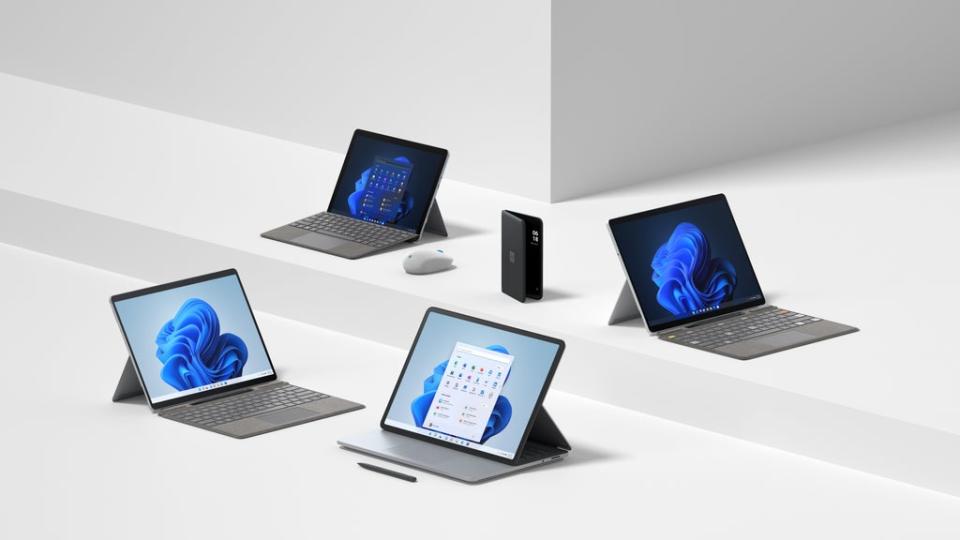Microsoft announces four new laptops including the ‘most powerful Surface we’ve ever built’

Microsoft has announced its newest generation of Surface laptops, including a new Surface Laptop Studio, Surface Pro 8, Surface Pro 3, and updates to the Surface Pro X.
The $1599.99 Surface Laptop Studio, which Microsoft claims is the most powerful Surface the company has made, has a dual-hinged screen design.
The computer folds up vertically, like a traditional laptop, but then folds again to create a solid surface for drawing or other work on the 14.4-inch, 2400-by-1600 pixel, 120Hz touchscreen – like the larger Surface Studio and its subsequent iterations.
This is to swap between three modes: a ‘laptop mode’, a ‘stage mode’ where the display is pulled forward for watching videos or gaming, and a ‘studio mode’ for drawing, writing, and sketching with the Surface Slim Pen 2.
Around the side are two USB Type-C Thunderbolt ports, completely shunning the older USB Type-A models, a 3.5mm headphone jack, and one proprietary Surface Connect port
Inside, the device will house either 16GB or 32GB of RAM, with a removable SSD from 256GB to 2TB, and a quad-core Intel H35 i5-11300H or i7-11370H processor; for those that choose the latter, it will also be fitted with a Nvidia GeForce RTX 3050 GPU. Microsoft claims that the laptop will get around 18 hours of battery life on a single charge.
Microsoft is following this up with the $1099.99 Surface Pro 8, which the company claims is more than twice as fast as the Surface Pro 7 – and which had already leaked a few days before.
The major change Microsoft has made here is larger screen real estate – 13-inches instead of 12.3-inches at a 2880-by-1920-pixel resolution with a 120Hz refresh rate – two USB Type-C ports, and a move to the 11th generation Intel i5-1135G7 or i7-1185G7 processor.The laptop’s memory starts at 8GB, up to 32GB, and the removable solid stare starts at 128GB up to 1TB. The camera on the back has also been slightly upgraded, from 8MP to 10MP, but the forward-facing camera keeps the same 5MP resolution.
Microsoft claims that the device will have 16 hours of battery life and can be charged 80 per cent in little over one hour.
For the $899.99 Surface Pro X, Microsoft has pushed the cost to $899 and expanded native app support -bringing 64-bit versions of Microsoft office to devices as well as updating other applications such as Photoshop and Lightroom, as well as Zoom. The small $399.99
Surface Go 3, meanwhile, has been made 60 per cent faster with an Intel Core i3 processor.
All of these devices will come running Microsoft’s new operating system, Windows 11, which has caused a controversy over the number of old devices that will not be able to run it with full protections due to a niche chip requirement that meant even some of Microsoft’s own computers, including the Surface Pro tablets, the Surface Hub, and the Surface studio, would not be able to run Windows 11.
Microsoft also used the event to launch the Android-based Surface Duo 2, its dual-screen foldable phone.
Read More
Netflix gives away free TV shows and films to try and find new users
Tesla drivers are ‘inattentive’ when using Autopilot, researchers find

 Yahoo Finance
Yahoo Finance 